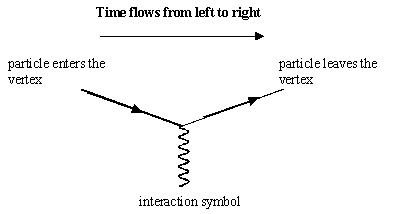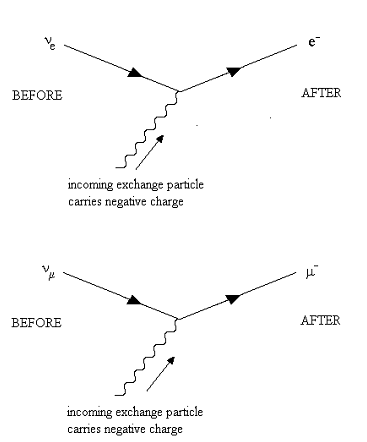8. Feynman vertices
Each of the three basic interactions can be described using a symbol called a
Feynman vertex. To the particle physicist, each Feynman vertex represents a
component of some sophisticated mathematics that is used to calculate various aspects
of particle interactions. But we can use the vertices in a non-mathematical
way to illustrate how quarks and leptons interact with each other. There
are three basic vertices, each one associated with each of the fundamental
interactions. There is an electromagnetic interaction vertex, a weak interaction
vertex and a strong interaction vertex. The basic structure of a vertex is
like this:

In the basic vertex shown above, the interaction propagator symbol has been
drawn vertical. When drawing interactions it is usual to incline the propagator
symbol to suggest that it is moving towards or away from the interaction
point.
Typical Feynman vertices look like:

Important points to note about Feynman vertices:
-
It is important to recognise that a vertex is simply a symbol,
it does not represent tracks of particles in space and it is not a space-time
diagram
-
The symbol is read from left to right. The left hand side
of the symbol shows the nature of the particle before the interaction and
the right hand side shows the nature of the particle after the interaction.
(Note: it is also common to find Feynman diagrams using the convention that
time flows from the bottom of the diagram to the top. This is just a matter
of taste but the left to right convention is more commonly used)
-
We use a forward facing arrow to represent a particle
travelling forwards in time and a backward facing arrow to represent an
antiparticle also travelling forwards in time. Some people find this convention
difficult to get used to at first, but after a bit of practice it comes
naturally. It is a useful convention as you will see when you construct
Feynman diagrams to show interactions.
The arms of each vertex can be rotated about the vertex point to generate
the full set of possible interactions that the vertex can represent. There
will be three vertices in which a single particle enters and two leave,
and three vertices in which two particles enter and one leaves.
The next bit is an important bit.....and it is the key to understanding
and interpreting the diagrams:
When the arm of a vertex is rotated, the direction of the arrows in the line
retain their direction with respect to the interaction point. For a particle
entering a vertex, the arrow will be directed towards the interaction point.
If the arm of the vertex representing this particle is now rotated so that
it represents a particle leaving the vertex, the arrow will still point towards
the interaction point but it will be pointing in a backwards direction. This
tells us that the particle leaving the reaction must be an antiparticle.
The effects of rotating the arms can be seen in the lepton vertices and quark
vertices sections.
Back to building particles
Index page Next
page: constructing Feynman vertices of purely leptonic interactions


